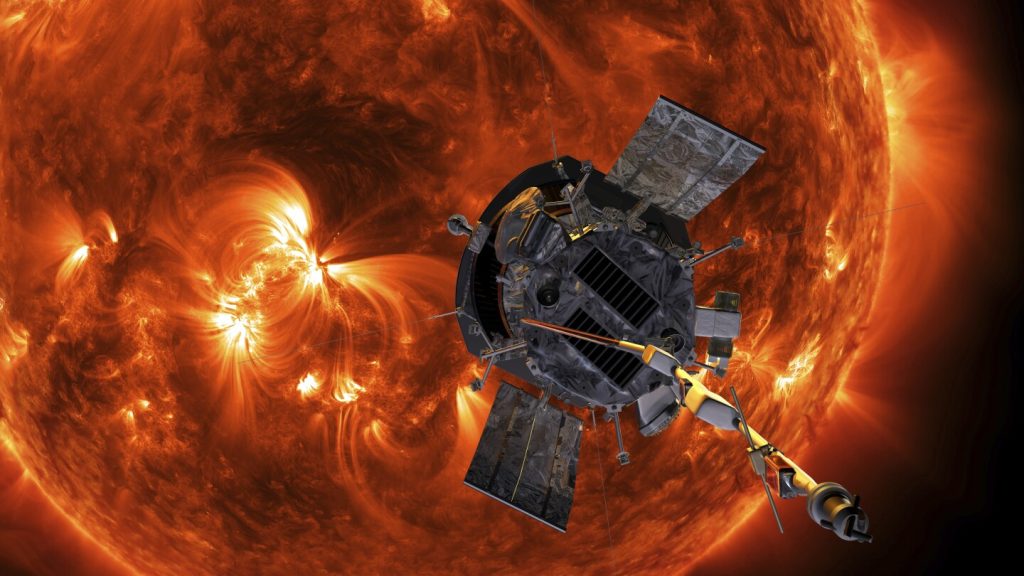Paragraph 1: A Daring Solar Rendezvous
NASA’s Parker Solar Probe, launched in 2018, is on a mission to unravel the mysteries of the sun. This ambitious spacecraft has already achieved the remarkable feat of flying directly through the sun’s corona, the ethereal outer atmosphere that becomes visible during total solar eclipses. In a historic maneuver scheduled for Tuesday, Parker is poised to shatter its own record for the closest approach to the sun, venturing within a mere 3.8 million miles (6 million kilometers) of the solar surface. To put this in perspective, if the sun and Earth were positioned at opposite ends of a football field, Parker would be a mere four yards from the sun’s fiery goal line.
Paragraph 2: Pushing the Limits of Space Exploration
This daring close approach represents a giant leap forward in solar science. Parker will be more than seven times closer to the sun than any previous spacecraft, subjecting itself to extreme conditions and unprecedented speeds. Hurtling through the solar atmosphere at a staggering 430,000 mph (690,000 kph), Parker will become the fastest human-made object ever. To withstand the scorching temperatures of up to 2,500 degrees Fahrenheit (1,371 degrees Celsius), the spacecraft is equipped with a cutting-edge heat shield, a testament to human ingenuity.
Paragraph 3: A Silent Dive into the Solar Furnace
Due to the intense solar radiation and interference during the close approach, communication with Parker will be temporarily suspended. Mission managers will have to wait anxiously for several days before they can re-establish contact and confirm the spacecraft’s status. This period of radio silence is a necessary trade-off for the invaluable scientific data that Parker is expected to gather during its intimate encounter with the sun.
Paragraph 4: Unraveling the Sun’s Secrets
Parker’s primary mission is to shed light on two fundamental solar enigmas: the extreme temperature of the corona and the driving forces behind the solar wind. Scientists have long puzzled over why the corona, the sun’s outer atmosphere, is hundreds of times hotter than its surface. Understanding the mechanisms that heat the corona is crucial for comprehending the dynamics of the sun’s atmosphere. Furthermore, Parker will investigate the solar wind, a supersonic stream of charged particles that constantly emanates from the sun. This continuous outflow of particles influences the space environment throughout our solar system and can have significant impacts on Earth’s technology and infrastructure.
Paragraph 5: The Sun’s Dual Nature
The sun, the celestial body that sustains life on Earth, also possesses a more turbulent and potentially disruptive side. While the sun’s energy fuels our planet’s ecosystems and drives weather patterns, intense solar storms can wreak havoc on our technological systems. These storms can disrupt radio communications, interfere with satellite operations, and even cause power outages. Understanding the sun’s volatile nature is therefore essential for protecting our technological society from its potentially harmful effects.
Paragraph 6: A Peak in Solar Activity
Parker’s daring mission coincides with a particularly active phase of the sun’s 11-year cycle. This period of heightened solar activity manifests as increased sunspots, flares, and coronal mass ejections. These events can trigger spectacular auroras – the shimmering curtains of light visible in the polar skies – even at lower latitudes than usual. The sun, our closest stellar neighbor, is a source of both wonder and potential danger, a powerful force that shapes our planetary environment and deserves our closest scientific scrutiny. Parker’s close encounter with our star promises to unlock profound secrets about the sun’s dynamic processes and their influence on Earth and the surrounding space environment.

